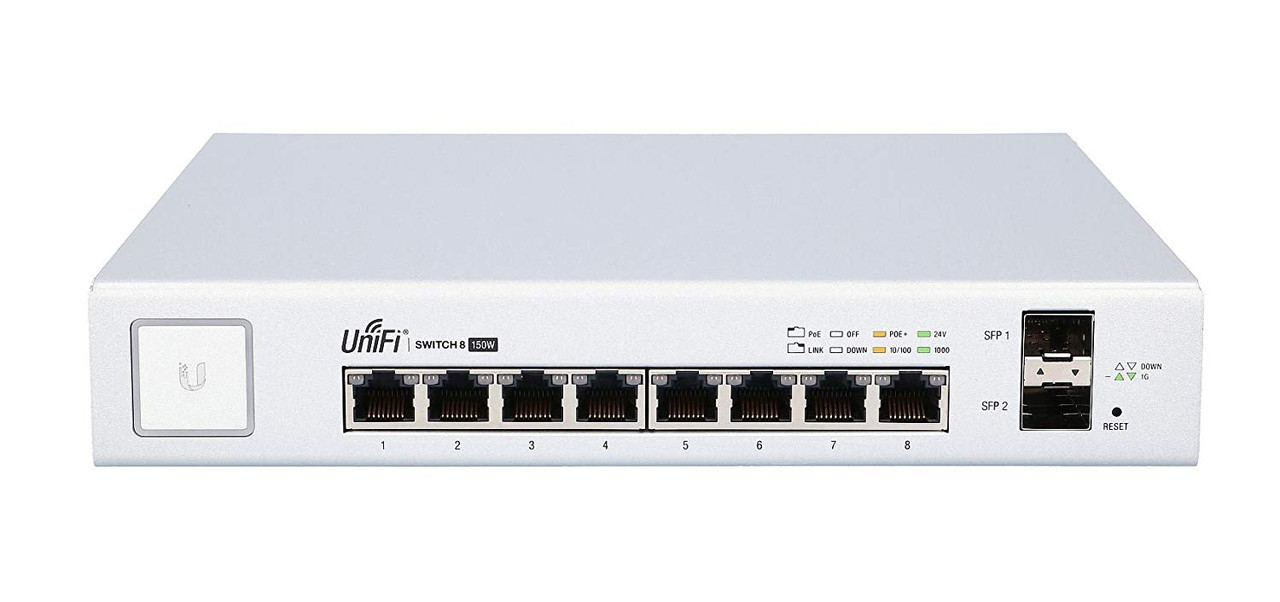|
It's probably cheaper to get a business broadband connection with a block of IPv4 addresses. IPv6 alone isn't enough to guarantee a fix to this issue if the game you want to play doesn't run on IPv6.
|
|
|
|

|
| # ? May 29, 2024 15:30 |
|
Why not just switch to NAT? As I understand it, the problem stems from not using NAT on two consoles at once.
|
|
|
|
I imagine his router is using NAT, but can't map a single inbound port to more than one xbox.
|
|
|
|
WattsvilleBlues posted:Multiple xbox ones, one internet connection.
|
|
|
|
Question: If I buy this Ubiquiti US-8-150W switch:  Then what are the advantages of the two SFP sockets on the right hand side? If I buy another one further down the line, can I run fibre between two of these puppies and have one downstairs and one upstairs, effectively having a solid source of ethernet on both levels of a home? From what I've quickly read, the SFP sockets can accommodate CAT5/6 or fibre, depending on which adaptor you connect. Does one transmit and one receive if you connect them up to the same socket on the same type of unit, or are they both doing dual-direction of the traffic?
|
|
|
|
Still can't map the same port to more than one Xbox at once, which can cause issues with specific games or services. apropos man posted:Question: No, they both transmit/receive, depending on which transceiver you have installed. They're useful for the variety of transceivers you can use with them, especially since there's a bit of a variety in types of fiber optic cable types, wavelengths, and power levels. Single mode vs multi-mode, and there are also special long range SFPs for long cable runs. In most houses, you're not going to exceed a 300ft cable run, so fiber isn't really needed, you can just run cat5/6 between the two switches. It's much cheaper and easier than running fiber. n0tqu1tesane fucked around with this message at 16:23 on Aug 13, 2018 |
|
|
|
On the flip side if you have a NAS and want to make sure that network wire speed is never a bottleneck there is that.
|
|
|
|
I ordered a Raspberry Pi to make a Pihole for my home network. Wish me luck.
|
|
|
|
Huh, pihole seems like a great use of the old first gen rpi that I have kicking around. Guess I have a project to keep me busy now.
|
|
|
|
I haven't used it yet, on my to-do list, but you can also run pi-hole in Docker. You don't actually need a Raspberry Pi. https://hub.docker.com/r/diginc/pi-hole/
|
|
|
|
n0tqu1tesane posted:
Ah, so I guess you only need to connect a single SFP cable between boxes (fibre or RJ45) to get a decent connection? And I assume that doubling up with two lots of cables is for if you want an extreme/hardcore transfer rate? As for Pi-Hole, anyone trying it for the first time should be golden. It's so well scripted that it's a piece of cake to set up. I recently had mine running with encrypted DNS through cloudflare as per this guide: https://scotthelme.co.uk/securing-dns-across-all-of-my-devices-with-pihole-dns-over-https-1-1-1-1/ Someone linked to that guide on here and it worked well for a while. But then with the latest Pi-Hole update mine seemed to get broken. I think it's because Pi-Hole have stopped using dnsmasq and the guide I linked to uses dnsmasq. So I reverted back to using Pi-Hole normal unencrypted DNS.
|
|
|
|
I want to set up a two-router system in my home for better WiFi coverage and more available wired connections. The house is wired for coax and we're not planning to use cable TV, so I'm looking into MoCA. I read the link in the OP and think I know what I need, but wanted to get confirmation before I order anything. One of the routers is a modem/router combo with coax in, ethernet out, and the other is a standard ethernet in/out. Both provide WiFi. I plan to put them in separate rooms on two different floors, each with a single coax cable coming in. So here's how I think I need to set it up, hopefully this makes sense: code:Assuming that pans out, I want the modem/router to be the only one communicating out, and the 2nd router to just provide additional wired and wireless connections into the primary network. I think running that router as an access point with the same SSID as the primary should accomplish what I want - anything connected by ethernet or WiFi to the 2nd router will get passed along to the primary, which will then send it out to the internet. Do I have all that right?
|
|
|
|
Nibble posted:I want to set up a two-router system in my home for better WiFi coverage and more available wired connections. The house is wired for coax and we're not planning to use cable TV, so I'm looking into MoCA. I read the link in the OP and think I know what I need, but wanted to get confirmation before I order anything. Your FIOS router may already be a MoCA adapter, too. Mine talks to the set top box in the house over moca. Under "My Network" they show up as Coax as the connection type, instead of ethernet. In network connections they show Ethernet/Coax as one of the options. If that's the case for you, too, then you need one moca adapter for where you're putting your second router. If you already have a spare router you want to use, that's cool, but if you were going to buy something, instead of a second router, just get a wireless access point like a UniFi AC Lite.
|
|
|
|
Nibble posted:I want to set up a two-router system in my home for better WiFi coverage and more available wired connections. The house is wired for coax and we're not planning to use cable TV, so I'm looking into MoCA. I read the link in the OP and think I know what I need, but wanted to get confirmation before I order anything. I don't think so. You only need one router, which will get the signal from the cable modem (or be one-and-the-same device, sounds like you may already have a combo box). Then you'll run Ethernet to the first MOCA adapter, that will run over coax to the other MOCA adapter, then you can hang a switch (for wired clients) and an AP (for wifi) off of it. You can use a wireless router to accomplish the last two things but you need to turn off all the routing functions.
|
|
|
|
Internet Explorer posted:I haven't used it yet, on my to-do list, but you can also run pi-hole in Docker. You don't actually need a Raspberry Pi. Oh that's neat. I've never used Docker before, but If I had a server going already I'd look into it. I'm mostly interested in an excuse to buy a RPI to play around with.
|
|
|
|
apropos man posted:Question: (1) It's an 8-port PoE+ switch that has 48v 802.3af/at or 24v passive PoE on all 8 ports, (2)plus an additional two SFP sockets to plug in either copper 1000BASE-T SFP modules (and plug in cat5/cat6) or 1000BASE-SX / LH singlemode or multimode fiber patch cables. Since it's a (3)fully managed (lol enterprise) switch you can team multiple ports together with LACP and get (not really) double the bandwidth (4) with two ports teamed. That's handy for NAS servers or switch-to-switch uplinks. Chances are you're not going to stress even a single gigabit LAN, so those features are lost on 95% of users. *1 - Many "PoE" switches don't support the high-wattage 802.3at PoE specification that lol-super-beefy access points require. Many PoE switches only have PoE on a few of the ports, including the smaller UniFi 8-port US-8-60W and US-8. *2 - The two extra ports means it's really a 10-port switch, not just 8 ports. You can power 8 PoE devices, phones, cameras, WiFi APs, up to 150 watts total PoE consumption and then use the SFP sockets for uplinks to other switches, router, etc. *3 - It's got a ton of features like port security, authentication, VLANs, port-channel bonding, etc etc etc. Home users typically never use any of these features. *4 - LACP has a few strategies for bonding two ports together but the short answer is that each transfer only uses one link at a time, so your speedtest won't suddenly show 2gig. And LACP does not fix WiFi throughput, nor does it make a PC connected with 1x gigabit port operate at 2gig/sec.
|
|
|
|
Rexxed posted:Your FIOS router may already be a MoCA adapter, too. Mine talks to the set top box in the house over moca. Under "My Network" they show up as Coax as the connection type, instead of ethernet. In network connections they show Ethernet/Coax as one of the options. Yeah I already own the second router. I was thinking that might not work because it's only looking to talk to the FiOS origin point via the direct coax in, but if it can talk to other local MoCA devices then that's great. One less adapter to buy, one less splitter's worth of signal degradation. thiazi posted:I don't think so. You only need one router, which will get the signal from the cable modem (or be one-and-the-same device, sounds like you may already have a combo box). Then you'll run Ethernet to the first MOCA adapter, that will run over coax to the other MOCA adapter, then you can hang a switch (for wired clients) and an AP (for wifi) off of it. You can use a wireless router to accomplish the last two things but you need to turn off all the routing functions. Since it is a wireless router, what functions do I need to turn off? I found a couple resources specific to my router (Archer C8) that say it's just a matter of changing the local IP to not conflict with the primary modem/router, turning off the DHCP server, and making sure the WiFi SSID/password match up.
|
|
|
|
Armacham posted:Oh that's neat. I've never used Docker before, but If I had a server going already I'd look into it. I'm mostly interested in an excuse to buy a RPI to play around with. Oh yeah, more power to you. Just wanted to share incase anyone else is interested in it and doesn't want to buy a RPI. I'm looking for excuses to play with Docker. 
|
|
|
|
Nibble posted:Yeah I already own the second router. I was thinking that might not work because it's only looking to talk to the FiOS origin point via the direct coax in, but if it can talk to other local MoCA devices then that's great. One less adapter to buy, one less splitter's worth of signal degradation. Turning off the DHCP should normally be all you need to do. Make sure you are plugging into the LAN ports on the routers that are acting as Access Points, unless you can change to WAN to LAN in the interface.
|
|
|
|
Nice, thanks guys. I ordered one MoCA adapter for my existing router, and if that doesn't do it I'll just get the second one and a splitter.
|
|
|
|
n0tqu1tesane posted:Still can't map the same port to more than one Xbox at once, which can cause issues with specific games or services. How does anyone get 2 Xboxes working properly from the same network, generally? Surely hardly anyone is getting a business account and getting extra IP addresses? If I had IPv6 and a router that supports certain settings, would I still have problems? I'm shocked that it's such an issue in this day and age 
WattsvilleBlues fucked around with this message at 23:36 on Aug 13, 2018 |
|
|
|
CrazyLittle posted:(1) It's an 8-port PoE+ switch that has 48v 802.3af/at or 24v passive PoE on all 8 ports, (2)plus an additional two SFP sockets to plug in either copper 1000BASE-T SFP modules (and plug in cat5/cat6) or 1000BASE-SX / LH singlemode or multimode fiber patch cables. Since it's a (3)fully managed (lol enterprise) switch you can team multiple ports together with LACP and get (not really) double the bandwidth (4) with two ports teamed. That's handy for NAS servers or switch-to-switch uplinks. Chances are you're not going to stress even a single gigabit LAN, so those features are lost on 95% of users. You're a more knowledgeable at networking standards than I am, but I am looking to hook it up to a home system that's got decent throughput. I currently have: • 2x Unifi AC PRO (I plan to power one straight from the Unifi switch and the other is currently on a POE+ adaptor in the hallway), • miniPC router running pfSense (Haswell i3, 4GB RAM, mSATA SSD with 4 gigabit ports) • Raspberry Pi 3 running as the Unifi controller/web interface • Cheap and nasty TP-Link 8 port managed switch I'm running two WiFi VLANs on the AP's and also have 3 ports on the cheap switch tagged as separate VLANs: the rest are trunked. The cheap managed switch is a pain in the arse to configure VLAN's and involves removing it from the network completely and connecting directly to my laptop via cable and configuring a static IP just to get the web interface up. I didn't say I expected to get double the speed if I connected both SFP's with a second US-8-150W. As you say, there's also a 60W variant that doesn't have the SFP connectors and costs half the price. I reckon the cheaper one would be plenty to power one of my AC PRO's but I'm willing to pay the extra now, in case I want to conjoin two of them at a later date. I reckon I've spent somewhere in the region of £550 to have a nice home networking setup that should last a few years and I feel that the lovely £35 switch is letting the side down. It'll be really nice to be able to configure my VLANs in the same web interface as my AP's, too. Is there any reason why connecting two US-8-150W's with two cables wouldn't be beneficial in terms of latency? I'm thinking two pathways are better than one. If I'm ever in a situation where I'm gonna be making a hole somewhere to pass a cable through to an upstairs switch why not go the whole hog and pass two lines through? apropos man fucked around with this message at 23:38 on Aug 13, 2018 |
|
|
|
I've got a fun question. I want to host a server on my personal computer running Windows 10 for my friends so we can all play a game together. Problem is we work opposite shifts so they asked me to leave the server running while I'm at work. I'm happy to oblige but I was wondering if there was an easy remote support tool I can use from my Android phone to do things like reset the connection or launch/close the game while I'm at work. If it matters the game is openRCT2. As far as I know the game doesn't seem to have a command line.
|
|
|
|
I haven't used it myself but there's a microsoft remote desktop client https://play.google.com/store/apps/details?id=com.microsoft.rdc.android and you could just remote in and do stuff. Might get bogged down hard if you have to actually have the game and lots of motion on the screen up to do your stuff and you don't have a great connection.
|
|
|
|
um excuse me posted:I've got a fun question. I want to host a server on my personal computer running Windows 10 for my friends so we can all play a game together. Problem is we work opposite shifts so they asked me to leave the server running while I'm at work. I'm happy to oblige but I was wondering if there was an easy remote support tool I can use from my Android phone to do things like reset the connection or launch/close the game while I'm at work. Teamviewer until they decide you are using it commercially and block you.
|
|
|
|
um excuse me posted:I've got a fun question. I want to host a server on my personal computer running Windows 10 for my friends so we can all play a game together. Problem is we work opposite shifts so they asked me to leave the server running while I'm at work. I'm happy to oblige but I was wondering if there was an easy remote support tool I can use from my Android phone to do things like reset the connection or launch/close the game while I'm at work. I used to use teamviewer for this kind of thing until they went "commercial use detected" crazy. Lately I've been using AnyDesk which is very similar. There's also Chrome Remote Desktop which I haven't used much but seems decent.
|
|
|
|
Chrome remote desktop works really well for basic clicking of things. It is really bare bones though.
|
|
|
|
nth-ing TeamViewer, cause you can do the most with the most ease, and if the actually block you, you just change the MAC address of your NIC
|
|
|
|
Armacham posted:I ordered a Raspberry Pi to make a Pihole for my home network. Wish me luck. DietPi made it easy for me to do this + PiVPN. Having said that, I just Dockerized my home server so I have no hesitation recommending that too
|
|
|
|
apropos man posted:I didn't say I expected to get double the speed if I connected both SFP's with a second US-8-150W. As you say, there's also a 60W variant that doesn't have the SFP connectors and costs half the price. I reckon the cheaper one would be plenty to power one of my AC PRO's but I'm willing to pay the extra now, in case I want to conjoin two of them at a later date. 60W is enough for 4 PoE 802.3af 48v (15w max) ports. Which is also the number if PoE ports the US-8-60W has. I'm not sure what you mean by "conjoin two of them" means in the context of talking about APs. You'll likely never need to bond ports for an access point. The only thing I can think of off the top of my head that needs 25-30w 802.3at PoE+ is something like the UniFi UAP-AC-HD or UAP-AC-SHD which has something absurd like 4 discreet radios built in.
|
|
|
|
CrazyLittle posted:60W is enough for 4 PoE 802.3af 48v (15w max) ports. Which is also the number if PoE ports the US-8-60W has. I'm not sure what you mean by "conjoin two of them" means in the context of talking about APs. You'll likely never need to bond ports for an access point. Maybe conjoin was a stupid word to use (probably!). I meant join the two 150W switches and have an AP running from each: one upstairs and one downstairs. I know that I could get two of the cheaper ones and network them together with a length of CAT5 or CAT6 but, y'know, this is the Serious Hardware/Software Crap and I don't mind overdoing it just because it can be done. Aren't those SFP ports used exactly for this sort of purpose in data centers, where you'd have a bunch of regular ethernet ports on a rack server and then use SFP to bridge two servers together for a direct link? That's the way I'm imagining. EDIT: I think the penny has dropped as to what you're saying. There's not much point in buying the 150W over the 60W switch unless you're covering long distances with the SFP? Because you're still only getting a 1Gb throughput, which the 60W switch will also do? Is that what you're suggesting? apropos man fucked around with this message at 18:39 on Aug 14, 2018 |
|
|
|
apropos man posted:Aren't those SFP ports used exactly for this sort of purpose in data centers, where you'd have a bunch of regular ethernet ports on a rack server and then use SFP to bridge two servers together for a direct link? That's the way I'm imagining. All that the SFP port gets you is modular optics so that you can run your preferred variety of fiber instead of copper if preferred; from a logical perspective, it's still a 1GbE port that performs exactly the same way. Enterprise gear often has SFP+ ports which support 10Gb operation (and/or other interface types like QSFP to go even faster) but I think it's still more common to connect physical nodes with a fast top-of-rack switch than directly. I am not a designer or a datacenter guy, but the topologies that I am familiar with tend to look more like a hierarchical tree than a full mesh - you have some capacity for traffic within a layer of the network ("east-west") in addition to passing between layers or into/out of the network ("north-south"), but that's not really the focus traditionally.
|
|
|
|
Well I've realised that I almost wasted money on the 150W SFP version. I actually ordered one a couple of days ago but the Amazon seller cancelled my order the next day due to a mis-price (it was only underpriced by about £7). So I'm gonna get the 60W version of the same switch without the SFP. It'll still be interoperable with a second switch when I buy one, still do gigabit on the ports, still do VLANs via the Unifi web interface and still power up my AC-PRO's. So it does everything I want and I've saved myself £60 or £70! :-)
|
|
|
|
Looking for a 10 GbE base-T adapter, is there any reason to prefer Intel over Aquantia?
|
|
|
|
Paul MaudDib posted:Looking for a 10 GbE base-T adapter, is there any reason to prefer Intel over Aquantia? Isn't the Intel stuff about 2x the price of the Aquantia stuff? I know Intel nics have great support for linux, BSD, Windows Server, etc. No idea about Aquantia. Far as I can tell they perform similarly.
|
|
|
|
Intel have proven themselves lately to be just as poo poo as anybody else to the point where it’s no longer a given that it’s the route to a hassle-free life.
|
|
|
|
^^^ For NIC drivers?! This makes me unhappy. I got a 16 port gigabit Ubquiti 150w PoE switch and noticed the paperwork says: "Non-Blocking Throughput: 18 Gbps • Switching Capacity: 36 Gbps" Any idea what non-blocking throughput means?
|
|
|
|
Thanks Ants posted:Intel have proven themselves lately to be just as poo poo as anybody else to the point where it’s no longer a given that it’s the route to a hassle-free life. lol. sigh
|
|
|
|
redeyes posted:^^^ For NIC drivers?! This makes me unhappy. A quick search suggests that it means that if you're actually using all ports at once then you'll get a full gigabit speed on each port. If you buy a cheap switch (like my TP-Link which is getting replaced when my Ubiquiti 8-port arrives this week) then you'll often find that the internals can't cope with delivering full gigabit on all ports at once: the bandwidth is shared internally. I guess it depends how cheaply made the switch is to how many ports at once you can get full gigabit on. There's probably a better, more in-depth explanation but you should be able to push all 16 ports with full duplex gigabit traffic all at once.
|
|
|
|

|
| # ? May 29, 2024 15:30 |
|
apropos man posted:There's probably a better, more in-depth explanation but you should be able to push all 16 ports with full duplex gigabit traffic all at once. That's basically it, yep.
|
|
|


































